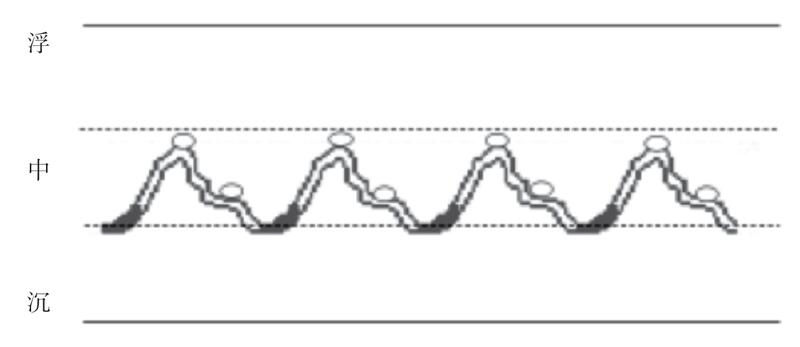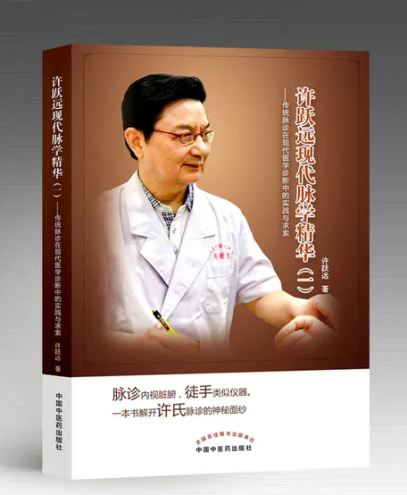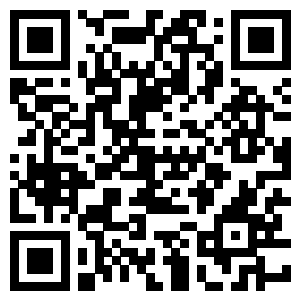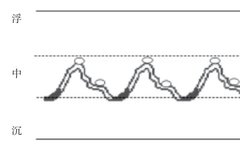 Reading Traditional Chinese MedicineEvery day11:30Latest updates
Reading Traditional Chinese MedicineEvery day11:30Latest updates
Authoritative knowledge of TCM
Editor’s Introduction
In historical dramas, it is common for doctors to say, “Congratulations, madam, you are pregnant” after feeling the pulse. The “slippery pulse” that assists in diagnosing pregnancy is actually a pulse type in TCM. However, the slippery pulse is not exclusive to pregnant women; it can appear in both genders under normal bodily conditions and various diseases. Today, we will explore the significance of the slippery pulse.
Standard of Slippery Pulse SensationAccording to the Classic of Pulse: “The pulse comes and goes, flowing smoothly and turning, resembling a series of beads.”Throughout history, physicians have regarded the description of “flowing” in the slippery pulse as authoritative.In various pulse literature, the discussion of slippery pulse aligns with the flowing description in the Classic of Pulse.Li Shizhen from the Ming Dynasty described the slippery pulse in Pulse Studies of Binhai as: “The slippery pulse comes and goes, flowing smoothly and turning, resembling beads, slick as if wanting to slip away.”Li Shizhen agreed with Wang Shuhe’s understanding of the flowing nature of the slippery pulse, opposing the view that slippery pulse contains a rapid pulse component, suggesting that the description of “beads” and “slick” is the initial concept of “beads rolling on a plate”.
In fact, the slippery pulse merely indicates smooth blood flow and does not signify a change in pulse frequency; if there is a rapid pulse component, it indicates a combination of slippery and rapid pulses.
Understanding of Slippery Pulse in TCMWhen the pathogenic factors are strong and the righteous qi is not deficient, there is a struggle between the righteous and the pathogenic, leading to a surge of qi and blood, hence the pulse flows smoothly.Diagram of Slippery Pulse

Source: Essence of Modern Pulse Studies by Xu Yueyuan (Volume 1)
Modern Physiology and Pathology of Slippery PulseThe occurrence of slippery pulse is directly related to a sharp decrease in peripheral resistance, an increase in cardiac contractility, and enhanced vascular elasticity; when the heart contracts forcefully, blood flow velocity increases, and reduced peripheral resistance leads to unobstructed blood flow, while the elastic recoil of blood vessels (including microcirculation) creates a resonant state of blood flow.The forward movement of blood flow in the vessels is driven by the heart; only when there is low resistance and accelerated blood flow will the phenomena of forward and backward flow occur, which is a result of the elastic recoil of the vessels.The combined effects result in the sensation of a slippery pulse, akin to beads rolling on a plate, dew on a lotus, or the rhythm of a pendulum.
Physiological Slippery Pulse:Occurs when vascular elasticity is good, cardiac output is normal, and peripheral resistance is low.
Pathological Slippery Pulse:Occurs in conditions of peripheral vasodilation, reduced arterial elasticity, smooth vascular endothelium, and decreased blood viscosity.
Pregnancy-related Slippery Pulse:Occurs with increased hormone (progesterone) levels, peripheral vasodilation, and normal or slightly increased cardiac output. The characteristics of pregnancy-related slippery pulse include floating and slippery left cun pulse, right chi pulse, right guan pulse, or right guan chi pulse, forming a three-point resonance state. It is difficult to distinguish pregnancy-related slippery pulse from that during menstruation or ovulation; the principle is that increased cardiac output leads to a floating and slippery left cun pulse, increased blood supply to the uterus and pelvis leads to a floating and slippery right chi pulse, and enhanced liver detoxification or increased portal venous return leads to a floating slippery right guan chi pulse.
Fu Congyuan observed that the slippery pulse appeared in blood donors or normal individuals after alcohol consumption, characterized by reduced cardiac output, similar to pathological slippery pulse. Experimental slippery pulse created by intravenous infusion of dextran solution or vasodilators such as mistletoe extract exhibited cardiovascular characteristics similar to physiological slippery pulse.
Additionally, Li Haoran’s observations found that 95.8% of patients exhibited slippery pulse when sweating during fever, and patients with bronchial bleeding, pulmonary tuberculosis, renal tuberculosis, and ulcer disease showed slippery pulse before bleeding. It was also noted that patients with high fever who exhibited slippery pulse within 2-3 days after defervescence were likely to experience a recurrence of fever. In patients with bacterial dysentery, pulmonary tuberculosis, urinary tract infections, and chronic nephritis, even if clinically cured, the presence of slippery pulse indicates they are not truly healed.

Characteristics of Slippery PulseNature of Slippery Pulse:Specifically refers to the single factor of smooth pulse qi.Sensation of Slippery Pulse:Should feel smooth, with the rhythm of beads rolling on a plate, dew on a lotus, or the swing of a pendulum.
Combined Pulses with Slippery Pulse:As a factor of slippery pulse, it can combine with many pulse types. Common combinations include: floating slippery pulse, deep slippery pulse, scattered slippery pulse, fine slippery pulse, slippery rapid pulse, solid slippery pulse, wiry slippery pulse, slippery slow pulse, weak slippery pulse, empty slippery pulse, long slippery pulse, short slippery pulse, wind slippery pulse, flooding slippery pulse, and moist slippery pulse. Slippery pulse and rough pulse should not combine, as they have different pulse qualities. Slippery pulse and arterial pulse should not combine, as arterial pulse has the quality of slippery pulse.
Modern Clinical Significance of Slippery PulseSlippery pulse is commonly seen in various causes of anemia, liver diseases (such as cirrhosis, liver cancer, severe hepatitis), rheumatic diseases, active systemic lupus erythematosus, leukemia, malignant tumors, pregnancy-induced hypertension, acute infectious diseases, food poisoning, acute gastroenteritis, and the edema phase of acute and chronic nephritis, as well as in various febrile patients or during sweating before fever, in shock patients during microvascular dilation, during ovulation or pregnancy, after women’s midday rest, and before and after ejaculation in men.Clinical practice has proven that the slippery pulse has specific locations. Modern Clinical Significance of Slippery Pulse by LocationSlippery Cun Pulse:Seen in infections of the heart, brain, lungs, trachea, and bronchi, during the febrile phase and recovery phase of allergic diseases, also seen before and after cerebral hemorrhage, hyperthyroidism, goiter, and cervical lymphadenopathy.Slippery Guan Pulse:Seen in early and recovery phases of inflammation of the liver, gallbladder, pancreas, stomach, kidneys, and duodenum, also seen in vomiting, tumors, hyperfunction of the spleen, cervical lymphadenopathy, pregnancy, ovulation, and after midday rest.Slippery Chi Pulse:Seen in inflammation, bleeding, and lymphadenopathy of the intestines, urinary system, reproductive system, and lower limbs.Slippery Left Cun Pulse:Seen in left cerebral hemorrhage, left tinnitus, left sinusitis, myocarditis, endocarditis, pericarditis, left bronchitis, left pleuritis, during menstruation, pregnancy, ovulation, and after midday rest.Slippery Right Cun Pulse:Seen in right cerebral hemorrhage, right tinnitus, right sinusitis, right bronchitis, right pleuritis, pharyngitis, etc.Slippery Left Guan Pulse:Seen in inflammation of the spleen, stomach, gallbladder, pancreas, left kidney, left adrenal gland, tumors, and systemic metastasis, as well as prolonged low fever.Slippery Right Guan Pulse:Seen in inflammation of the liver, gallbladder, bile ducts, pancreas, duodenum, right kidney, and right adrenal gland, tumors, and stones.Slippery Left Chi Pulse:Seen in sigmoid colon inflammation, left ureter stones, left adnexal masses, and inflammation, stones, bleeding, and pain in the urinary, reproductive systems, and left lower limb.Slippery Right Chi Pulse:Seen in right ureter stones, right adnexal inflammation, masses, and urinary reproductive system, left lower limb diseases, and pregnancy.Slippery Left Chi and Right Guan Chi Pulses:Seen in women during menstruation, ovulation, and after midday rest, also seen in early to mid-pregnancy. Pregnancy in women cannot be concluded solely from the left cun and right guan chi pulses; these must be differentiated from pregnancy and other conditions.
Modern Clinical Significance of Slippery Pulse by LocationSlippery Cun Pulse:Seen in infections of the heart, brain, lungs, trachea, and bronchi, during the febrile phase and recovery phase of allergic diseases, also seen before and after cerebral hemorrhage, hyperthyroidism, goiter, and cervical lymphadenopathy.Slippery Guan Pulse:Seen in early and recovery phases of inflammation of the liver, gallbladder, pancreas, stomach, kidneys, and duodenum, also seen in vomiting, tumors, hyperfunction of the spleen, cervical lymphadenopathy, pregnancy, ovulation, and after midday rest.Slippery Chi Pulse:Seen in inflammation, bleeding, and lymphadenopathy of the intestines, urinary system, reproductive system, and lower limbs.Slippery Left Cun Pulse:Seen in left cerebral hemorrhage, left tinnitus, left sinusitis, myocarditis, endocarditis, pericarditis, left bronchitis, left pleuritis, during menstruation, pregnancy, ovulation, and after midday rest.Slippery Right Cun Pulse:Seen in right cerebral hemorrhage, right tinnitus, right sinusitis, right bronchitis, right pleuritis, pharyngitis, etc.Slippery Left Guan Pulse:Seen in inflammation of the spleen, stomach, gallbladder, pancreas, left kidney, left adrenal gland, tumors, and systemic metastasis, as well as prolonged low fever.Slippery Right Guan Pulse:Seen in inflammation of the liver, gallbladder, bile ducts, pancreas, duodenum, right kidney, and right adrenal gland, tumors, and stones.Slippery Left Chi Pulse:Seen in sigmoid colon inflammation, left ureter stones, left adnexal masses, and inflammation, stones, bleeding, and pain in the urinary, reproductive systems, and left lower limb.Slippery Right Chi Pulse:Seen in right ureter stones, right adnexal inflammation, masses, and urinary reproductive system, left lower limb diseases, and pregnancy.Slippery Left Chi and Right Guan Chi Pulses:Seen in women during menstruation, ovulation, and after midday rest, also seen in early to mid-pregnancy. Pregnancy in women cannot be concluded solely from the left cun and right guan chi pulses; these must be differentiated from pregnancy and other conditions. Modern Clinical Significance of Combined Slippery PulsesFine Slippery Pulse:Seen in neurasthenia, epilepsy, brain infections, brain injuries, and poisoning, as well as poor gastrointestinal function.Scattered Slippery Pulse:Seen in the pulse of the affected side in stroke patients.Slippery Slow Pulse:If the defensive qi is full, it is a healthy pulse; if pathological, it is often seen with internal heat.Weak Slippery Pulse:Commonly seen in infectious diseases of the urinary and reproductive systems.Wind Slippery Pulse:Seen in hemorrhagic strokes.
Modern Clinical Significance of Combined Slippery PulsesFine Slippery Pulse:Seen in neurasthenia, epilepsy, brain infections, brain injuries, and poisoning, as well as poor gastrointestinal function.Scattered Slippery Pulse:Seen in the pulse of the affected side in stroke patients.Slippery Slow Pulse:If the defensive qi is full, it is a healthy pulse; if pathological, it is often seen with internal heat.Weak Slippery Pulse:Commonly seen in infectious diseases of the urinary and reproductive systems.Wind Slippery Pulse:Seen in hemorrhagic strokes.
Moist Slippery Pulse:Seen in ear-related deafness, labyrinthitis, and motion sickness.
Essential Reading on Pulse Diagnosis
The author of this article, Professor Xu Yueyuan, is a renowned clinician who integrates Chinese and Western medicine, trained in Western medicine and from a family of TCM practitioners. He has spent 40 years researching meridians and proposed the diagnostic thought of “feeling the pulse of the person.” He believes that “pulse qi” reflects the constitution of the body, while “pulse shape” conveys the essence of diseases.


Essence of Modern Pulse Studies by Xu Yueyuan (Volume 1) – The Practice and Exploration of Traditional Pulse Diagnosis in Modern Medical Diagnosis
Click on the cover to enter the Yuyijia TCM Academy to purchase this book
Scan to read for free
This book explores the main ideas of “pulse shape” and “pulse qi,” revealing the secrets of pulse diagnosis for understanding diseases; it identifies pulse types such as edge pulse, wind pulse, turbid pulse, and tide pulse, standardizes the naming of combined pulses, and creates precise pulse diagrams for accurate localization. By studying this book, one can master the author’s pulse diagnosis thinking and clinical practical techniques, achieving a comprehensive understanding of diseases and symptoms.Copyright Statement
Some content of this article is excerpted from Essence of Modern Pulse Studies by Xu Yueyuan (Volume 1) – The Practice and Exploration of Traditional Pulse Diagnosis in Modern Medical Diagnosis (published by China Traditional Chinese Medicine Press, authored by Xu Yueyuan), with all rights reserved by the original author. This article is recommended for publication by Reading Traditional Chinese Medicine (WeChat ID: ydzhongyi) and reprinted by Kangaroo Medicine. The cover and images in the text are sourced from Shetu Network, with copyright belonging to the original author. If there is any infringement, please contact for deletion. Unauthorized reproduction is prohibited!
 Click“Read the original text”to purchase the recommended bookGood articles must be “looked at”
Click“Read the original text”to purchase the recommended bookGood articles must be “looked at”

